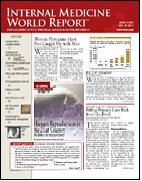Newswatch Moderate Alcohol Intake Increases BMD in Women
Newswatch
Moderate Alcohol Intake Increases BMD in Women
British researchers identified 46 pairs of female monozygotic twins who were discordant for alcohol intake. Within each pair, 1 twin consumed £1 unit of alcohol/week while the other consumed more than this amount. A unit of alcohol was defined as a half pint of beer, 1 glass of wine, or 1 measure of spirits. Women who drank an average of 8 units of alcohol/week had higher bone mineral density (BMD) at the hip and lumbar spine as compared with women who drank minimal amounts of alcohol. Markers of bone turnover were not associated with alcohol consumption or BMD, suggesting that alcohol does not exert its beneficial effects through alterations in bone formation or resorption (Ann Rheum Dis. 2004;doi:10.1136/ard.2004.022269).
ACP Issues New Angina Guidelines
New guidelines for the evaluation of chronic stable angina recommend first considering age, sex, risk factors, and symptoms to determine the probability of significant coronary artery disease in patients presenting with chest pain. Developed by the American College of Physicians for use in primary care, the guidelines advise that measuring left ventricular function by resting echocardiography (ECG) or resting radionuclide angiography in patients with chronic stable angina and a history of myocardial infarction, pathologic Q waves, signs or symptoms suggestive of heart failure, or complex ventricular arrhythmias. Exercise ECG should be the initial test for risk stratification in symptomatic patients with chronic stable angina who are able to exercise and are not taking digoxin. Exercise ECG is also recommended after a significant change in anginal pattern but is not recommended in patients with preexcitation, 1 mm ST-segment depression, or complete bundle branch block on resting ECG (Ann Intern Med. 2004;141:57-64).
Calcium Intake Linked to Reduced Colorectal Cancer Risk
Milk consumption and calcium intake are inversely related to the risk of colorectal cancer. In a pooled analysis of data from 10 cohort studies in 5 countries, dietary patterns were assessed in 534,536 persons who were followed for up to 16 years. Compared with the least milk intake (ie, <70 g/d), relative risk (RR) of colorectal cancer with increasing milk intake (ie, 70-174, 175-249, and ³250 g/d) was 0.94, 0.88, and 0.85, respectively. The RR for the highest versus the lowest quintile of intake was 0.86 for dietary calcium and 0.78 for combined dietary and supplemental calcium sources. The relationships were consistent across the studies and significant in men and in women. The inverse association for milk was limited to cancers of the distal colon and rectum (J Natl Cancer Inst. 2004;96:1015-1022).
BP Decreases in the Elderly Predicts Alzheimer’s
A ³15 mm Hg decrease in blood pressure (BP) predicts the development of Alzheimer’s disease (AD) in elderly persons who already have low BP or vascular disorders. The relationship between changes in BP and the development of AD and dementia was examined in 947 community-dwelling older adults who were dementia-free at baseline and followed for 6 years. BP markedly decreased during the 3 years before dementia diagnosis and afterward but not during the 3 to 6 years before dementia diagnosis. Among those with a baseline systolic BP <160 mm Hg, a systolic BP decline of ³15 mm Hg occurring 3 to 6 years before diagnosis was associated with a relative risk of 3.1 for AD or for dementia. Dose-response relationship between systolic BP decline and dementia risk was evident in those with vascular disease (Stroke. 2004;doi:10.1161/01.str.0000133128.42462.ef).
Thyroid Disorders Common with HCV Infection
Chronic with hepatitis C virus (HCV) infection is associated with increased rates of hypothyroidism and thyroid autoimmunity. Levels of thyroid-stimulating hormone (TSH), free thyroxine (T4), and triiodothyronine (T3), as well as antithyroglobulin and antithyroid peroxidase antibodies, were measured in 630 patients with chronic HCV infection. Mean TSH levels were significantly higher and free T4 and T3 levels were significantly lower in the patients with chronic HCV infection than in patients with chronic HBV infection, a control group of persons living in an iodine-deficient area, and a group living in an area of iodine sufficiency. Patients with chronic HCV infection were more likely to have hypothyroidism and antithyroid peroxidase antibodies than any of the other groups (Am J Med. 2004;117:10-13).
